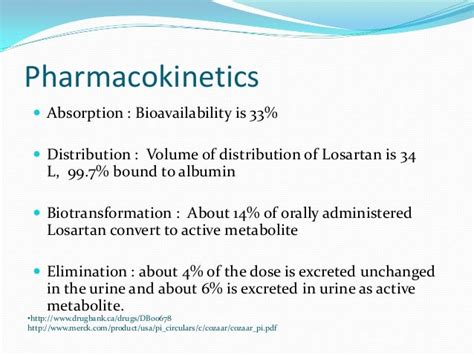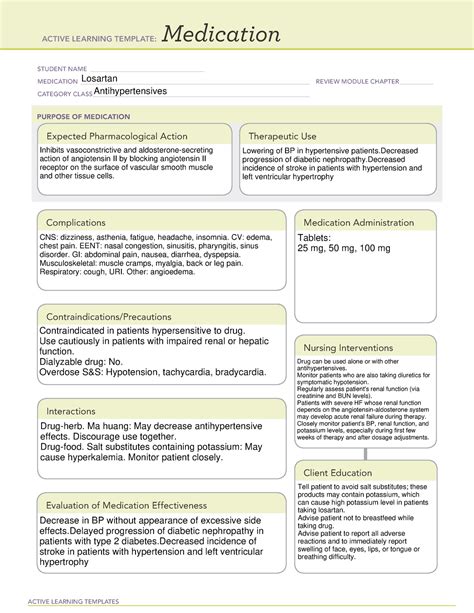Intro
Discover the 5 uses of Losartan, a potent angiotensin II receptor blocker, for managing hypertension, diabetic nephropathy, and heart failure, while also exploring its effects on cardiovascular health and potential off-label uses.
Losartan is a medication that has been widely used for the treatment of various health conditions, primarily focusing on its role as an angiotensin II receptor antagonist. This class of drugs is crucial in managing conditions related to the heart and blood vessels. The importance of understanding losartan's uses cannot be overstated, given its potential to improve the quality of life for individuals suffering from certain medical conditions. Losartan's mechanism of action, which involves blocking the action of angiotensin II, a potent vasoconstrictor, is key to its therapeutic effects. By doing so, it helps to relax blood vessels, thereby lowering blood pressure and reducing the strain on the heart.
The application of losartan in medical practice is multifaceted, reflecting its versatility as a therapeutic agent. For instance, its primary use in the management of hypertension highlights its role in preventing the complications associated with high blood pressure, such as heart disease and stroke. Moreover, losartan's benefits extend beyond blood pressure control, as it has been found to have protective effects on the kidneys, particularly in patients with diabetes. This aspect of its use underscores the medication's potential in reducing the risk of kidney disease progression, a significant concern for individuals with diabetic nephropathy.
The therapeutic landscape of losartan is continually evolving, with ongoing research aimed at exploring its full potential. This includes investigations into its effects on cardiovascular outcomes, its safety profile, and its interactions with other medications. As such, healthcare providers and patients alike must stay informed about the current understanding and recommendations regarding losartan's use. By doing so, they can make informed decisions about its incorporation into treatment plans, ensuring that patients receive the most effective and safe care possible.
Introduction to Losartan

How Losartan Works
Losartan's mechanism of action involves the selective blockade of the angiotensin II type 1 (AT1) receptor. Angiotensin II is a potent vasoconstrictor and a key component of the renin-angiotensin-aldosterone system (RAAS), which plays a central role in regulating blood pressure and fluid balance. By blocking the AT1 receptor, losartan prevents the vasoconstrictive and aldosterone-secreting effects of angiotensin II, leading to vasodilation and a decrease in blood pressure. Additionally, losartan has been shown to have beneficial effects on cardiac and renal function, making it a valuable therapeutic option for patients with heart failure and diabetic nephropathy.Uses of Losartan

Treatment of Hypertension
Losartan is effective in lowering blood pressure in patients with hypertension. It is often used as a first-line treatment, either alone or in combination with other antihypertensive medications. The dosage of losartan can vary, but it is typically started at 50 mg once daily and can be increased to 100 mg daily if needed.Protection of the Kidneys in Diabetes
For patients with type 2 diabetes, losartan has been shown to reduce the risk of kidney disease progression. It works by lowering blood pressure and reducing proteinuria (the presence of excess proteins in the urine), which are indicators of kidney damage. The protective effects of losartan on the kidneys make it an important consideration in the management of diabetic patients.Benefits of Losartan

- Blood Pressure Control: Losartan is effective in lowering blood pressure, which reduces the risk of heart attack, stroke, and kidney disease.
- Kidney Protection: Its protective effects on the kidneys can slow the progression of kidney disease in diabetic patients.
- Cardiovascular Risk Reduction: By controlling blood pressure and reducing the strain on the heart, losartan can decrease the risk of cardiovascular events.
- Safety Profile: Losartan is generally well-tolerated, with a favorable side effect profile compared to some other antihypertensive medications.
Side Effects and Interactions
While losartan is considered safe for most patients, it can cause side effects and interact with other medications. Common side effects include dizziness, back pain, and gastrointestinal upset. It is essential for patients to discuss any concerns or questions about side effects and potential interactions with their healthcare provider.Practical Considerations

Dosage and Administration
Losartan is typically administered orally, once daily, with or without food. The dosage may vary depending on the patient's condition and response to the medication. It is crucial for patients to follow the prescribed dosage regimen and not to stop taking the medication without consulting their healthcare provider.Future Perspectives

Emerging Trends and Research
Emerging trends in the use of losartan include its potential role in managing other conditions beyond hypertension and diabetic nephropathy. Researchers are also investigating its effects on cardiovascular outcomes and its safety profile in various patient populations. These studies will provide valuable insights into the full potential of losartan and guide its use in clinical practice.Conclusion and Final Thoughts

We invite readers to share their thoughts and experiences with losartan in the comments below. If you found this article informative, please consider sharing it with others who may benefit from this information. Your engagement and feedback are invaluable in helping us provide the most accurate and helpful content possible.
What is losartan used for?
+Losartan is primarily used to treat high blood pressure (hypertension) and to protect the kidneys from damage due to diabetes.
How does losartan work?
+Losartan works by blocking the action of angiotensin II, a natural chemical that narrows blood vessels, allowing blood vessels to widen and lowering blood pressure.
What are the benefits of taking losartan?
+The benefits of losartan include effective blood pressure control, protection of the kidneys in diabetic patients, and a reduction in the risk of cardiovascular events.
